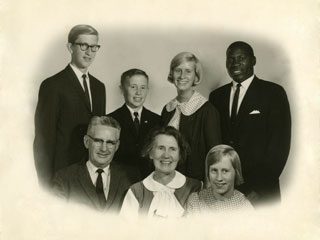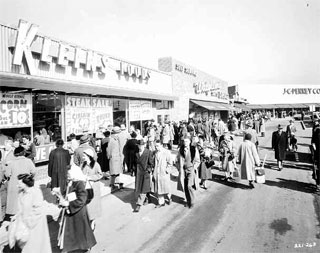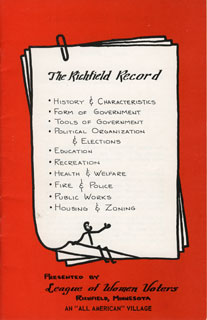Emily Day: Integrating Richfield
The post-war era saw the dawning of the Civil Rights movement across America. People of color were still living in largely segregated neighborhoods in the Twin Cities. In 1954, a booklet published by the League of Women Voters for new residents of the Minneapolis suburb of Richfield stated, "Richfield is a very homogeneous community with no significant sub-groups of racial, religious or economic minorities." Emily Day, whose family moved to Richfield in 1949, remembered the homogeneity of the population during those years, and her desire to see a more diverse community. She was interviewed by Thomas Saylor in 2007.
Audio
Transcript
TS: What was it like going into the classroom? What kind of families did you meet? What kinds of kids were there in school?
ED: Of course it was all white. I don't know what it is…this is kind of a little not on your question, but the fact that the schools were all white was a concern to my husband and me. And when our church asked if there were any people who would accept a boy from Africa to live in their home and go to the public schools, we said we would. So we got this boy who came to live with us from Malawi. Because how could our kids not even know there were black people in the world? It just seemed crazy. So we had him and then he stayed on with us and we helped him to go to college, and helped him to go to another college for the senior year. Then we helped him to go on, and finally after thirteen years he finished his last medical school for a specialty in tropical medicine and he went home.
TS: So he was here for thirteen years in the States?
ED: Off and on. Only the first year was he in Richfield. But he came back from college. So he had his own room here and he was part of our family, but he didn't live here when he was going to school in other places. His name was Trywell Nyirongo.
TS: So you had a young man from Malawi in your home starting in 1963. Let me ask you first: what prompted you...how did you make the connection to having a young man from Malawi come to Richfield? How did that happen?
ED: Well, we go to a Unitarian Church in St. Paul. ...And one time they said that they had learned that the State Department was aware that the African students who were coming here to go into college were not making it. And they thought that if they could find places where people could take these kids and let them go through public school in the senior high school for a year, then maybe they would be able to hack it in a university. So they asked at our church if there were any people who would be willing to have a boy from Africa. They weren't all from Malawi. Only one was from Malawi and one was from Kenya and one was from, I think, Uganda. So we thought that our kids really could use a black friend, a black brother, because our whole community was so isolated from blacks.
TS: That's interesting about Richfield. And at the time it was developing in the 1950s you're saying it was still all white.
ED: Absolutely. We went to the Hub, I remember, when Try first came. And we got out of the car to go into Penney's, I suppose, and he looked around at all the cars and all the people and he said, "I think I'll have to go home." There wasn't another black.
TS: And you in the schools at the time...was there any racial differentiation in the schools or were the schools all white, too?
ED: The school was almost all white. I don't remember any black kids that I had. I think it was all white.
TS: And you started there in 1958, so Richfield has been developing a number of years by that time.
ED: Oh, yes. Right. I suppose they must have been starting to get some, but I guess I didn’t identify that as a problem.
TS: How about your neighborhood? Were there any people of color in your neighborhood?
ED: No, no. Not at all. There are now. Thank goodness.
TS: How did this young man from Malawi play in your neighborhood? In other words, how did this all white community respond to that?
ED: I must say, he was wonderful and there were some young men that were in that same senior class who were just great with him. They had known some AFS [American Field Service Intercultural Program] students who had come for one year from different countries. There weren't any that came from a black country but they had known some foreign students who had come into the high school, and they thought of Try as another AFS foreign student, which was all right. But he just happened to be a black. That's all. And then after that year, instead of his going back home, which is what they assumed for the AFS students, he wanted to stay here because he was insistent that he was going to stay here until he got to be an M.D.
TS: So he lived with you in your house for a year, that one school year, right?
ED: Yes. And then he was here, you know, the next year when he was in Waldorf College down in Iowa. He was here on weekends and at Thanksgiving and Christmas and Easter and so forth, because Waldorf is very close. So the next two years he was in and out a lot. And then by the time he got to be a junior, he was in Ohio. He wasn’t here as much. He just came back on vacations and things like that.
TS: So the population in that school now is different from the school when you were there.
ED: It's over fifty percent non-white.
TS: So Richfield has changed demographically a lot since the 1950s and 1960s.
ED: Oh, absolutely. Absolutely. ...We have mixed neighbors now. We have mixed black and white kids there. I think it's just great. And I work real eagerly on our block parties. And we have had very good block parties where the gal next door has done a good job of making our neighbors feel like neighbors.
TS: That's good. That's what makes a neighborhood, isn't it?
ED: Absolutely.




Source
Day, Emily; Thomas Saylor, Interviewer, Richfield Oral History Project, Minnesota Historical Society Oral History Collections, 2007.


